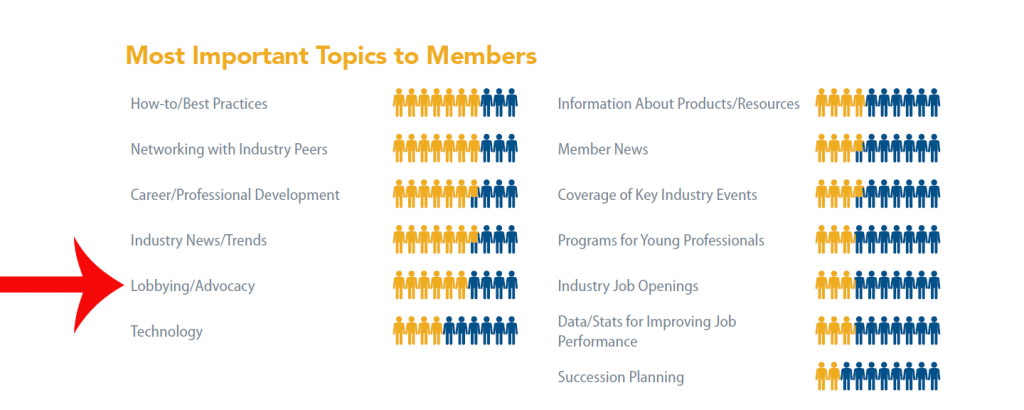How Top Leaders and Advocates Navigate Fast-Changing Times
Lessons learned from John Graham, astronauts Mark and Scott Kelly and more.

Some of you may remember Bob Dylan’s 1964 classic ballad “The Times They Are A Changin’.”
That song foreshadowed the tumultuous times of the late 1960s. It was also the year that identical twins Mark and Scott Kelly were born. The Kelly brothers, renowned U.S. astronauts who have a spent a combined 550 days in outer space, delivered a stirring keynote address at the recent ASAE annual conference in Salt Lake City about the importance of doing things that are hard. The Kelly brothers recounted how flying and aeronautics did not come as naturally to them as it did to some of their fellow trainees. “That’s why we’d like to talk to you today about having a goal, taking small manageable steps, controlling what you can control and not being afraid to take risks and make mistakes,” they related.
![]()
Help members see change that’s coming before it arrives on their doorstep. ![]()
Why members join your organization—and why you think they join—is not always the same. ![]()
Don’t just reach out blindly to legislators and policymakers—educate them with facts, data and hard evidence. ![]()
Boomer succession plans can be just as important as millennial recruiting. ![]()
The challenge, of course, is that boards tend to be risk averse, as noted by Terrance Barkan, Chief Strategist & Business Architect of GlobalStrat. At a recent panel discussion, Barkan described how he finally convinced his client, The International Coach Federation (ICF), to increase dues for the first time in 10 years. While ICF’s board long-feared angering members and triggering a wave of defections, the opposite occurred. As expected, raising dues did cause some members to depart, but it was mostly less-engaged (non-certified) members.
On the flip side, the higher dues price connoted “more prestige,” and ICF attracted a substantially larger number of more engaged members who were more likely to get certified and renew. Three years after rolling the dice on dues, ICF’s revenue grew to $6 million from $3.5 million and retention increased by 27 percent. A key to their success, said ICF CEO Magdalena Mook, was giving members plenty of heads up about the planned dues hike and really explaining, “why we’re doing it, not just what we’re doing.” That’s part of what the Kellys would call controlled, educated risk-taking.
Scott Wiley, president and CEO of the Ohio Society of CPAs (OSCPA) and the new ASAE Chair agreed. “Change is a constant for associations and all professionals.” Wiley, who sat down with Association Adviser for an exclusive interview last week, said, “We need to keep moving the ball down the court aggressively for our members and the industries we serve. It’s really the only way we will achieve results for our collective memberships that count on their associations to lead the way.”
While most industry participants appreciate your association’s advocacy efforts, Scott Hildebrand, CEO of Starboard Strategies, LLC told a large audience at the recent ASAE annual conference that you have to be creative to get non-member “freeloaders” to pay dues to join your association and get more deeply involved with your advocacy efforts.
For most industries and professions, Hildebrand said the main reasons that people join associations are for insurance, affinity discounts, professional training, networking and high-value information. Hildebrand said that advocacy is often on the secondary list of reasons that members join. But our annual Association Communication Benchmarking study showed that association leaders rate advocacy among the five most important topics to members (60 percent).

Our data also found that more than two in five associations (42 percent) are struggling to maintain their position as the industry’s No. 1 source of information — up from 28 percent in 2011. Further, nearly one-fourth of associations (23 percent) report having difficulty communicating legislative, regulatory and technical updates to members in a timely fashion — up from 13 percent in 2011. These disconnects need to be addressed ASAP!
Association Communication Challenges (% who agree)
| 2011 | 2016 | % Change | |
| Maintaining position as industry’s No. 1 info. source | 28% | 42% | +14% |
| Difficulty communicating legislative, regulatory, technical updates | 13% | 23% | +10% |
Source: Association Adviser Communications Benchmarking Survey 2016
One of Hildebrand’s longtime clients, The Master Builders Association, did an exhaustive member survey and found that 60 percent of MBA members were “happy and uninvolved.” To change that equation, Hildebrand suggested tapping into younger members since millennials are “activists by nature” and often looking for work and volunteer experiences “that matter.” He also suggested to tap other non-millennial members who genuinely want to get involved to support your industry or profession. Both groups are likely to have like-minded friends and professional colleagues, so you have an instant multiplier effect, he added.
When it comes to grassroots advocacy, Hildebrand said make sure well-intentioned volunteers are trained in how to contact legislators properly and that volunteers fully understand their role in your organization’s overall outreach strategy. Hildebrand also noted that at many associations, the government affairs folks are in silos and appear to be always out at lunch “making deals in smoke filled back rooms.” In reality, Hildebrand said advocacy “wins” can make a huge difference for your organization and your industry at large when everyone sees the results and understands what the government affairs teams are doing and vice versa.
Measuring results of advocacy initiatives
By making staff, not just members, more aware of your advocacy efforts you’re more likely to get additional support. Expanding on the work of the Annie B. Casey Foundation (A Guide to Measuring Advocacy and Policy), Hildebrand suggested five keys to showing/quantifying the results of your advocacy efforts.
- Shift in norms (change in public perception before vs. after your campaign).
- Strength in organization (improved membership numbers and community organization).
- Strength in alliances (more/better partnerships and alliances with like-minded groups).
- Strengthened base of support (increased public involvement, increased public action).
- Improved policies/new legislation (did you get a new rule, regulation or bill approved by legislators?)
It comes down to the “gumball theory” of government relations, quipped Hildebrand. He said you have to put a nickel in the gumball machine every single day. Sometimes you get nothing back in return. Sometimes one gumball comes out. Sometimes a whole load spills out when you least expect. The key is to keep the “drip” on at all times. He also suggested giving the media and general public — not just your narrow industry — a theme they can grab onto. For instance, at the Master Builders Association, it wasn’t just advocating on behalf of home builders — it was educating the public about how “We’re not just building homes; we’re building the American Dream where jobs come home to sleep,” related Hildebrand.
Trey Forgety, director of government affairs for the National Emergency Number Association said the goal for NEMAs government affairs program is to educate policy makers in Washington about 9-1-1 and its role across the government enterprise and how it “impacts everything from transportation to telecommunications to homeland security.”
Also take advantage of the deep data, hard facts and evidence that your organization has at its disposal — intelligence that few other organizations have — to influence policy makers. Sometimes advocacy is used to prevent a proposed bill or measure from becoming law. For instance when California was facing a proposal requiring hotels to have fitted sheets to protect housekeepers from back injuries, the Textile Rental Services Association of America (TRSA) knew this wasn’t the correct course of action. Thanks to evidence it had collected firsthand from hotel managers and housekeeping staff, TRSA President and CEO Joseph Ricci said his organization worked with the California Hotel & Lodging Association to point out several adverse factors and costs that would result from the proposed fitted sheet legislation. “We did some research that indicated there really wasn’t any difference in safety for the housekeepers between the fitted sheet and the flat sheet. They still had to lift up the mattress or bend down. Our research helped [housekeeping staff] make a bed more efficiently and safer.”
Advocacy can also be proactive rather than reactive. OSCPA’s Wiley said, “Our role is to help members anticipate what’s coming down the road before its right in front of them and to tell the rest of the world the critical role CPAs are playing as business drivers in our state.” Wiley said the talent gap is hitting Ohio firms and businesses hard as more Boomers retire. According to Wiley, OSCPA is “turning up the heat” on CPA career awareness for students as young as high school and remodeling accounting curriculum so CPAs develop the softer, non-technical skills demanded in today’s marketplace.
Funding advocacy efforts
Since member dues only go so far, many organizations have gotten creative about funding their advocacy initiatives. The Association of Nutrition and Foodservice Professionals (ANFP) starts simply by asking members to put their two cents in — literally. According to ANFP President and CEO, Joyce Gilbert, “We ask members for [a donation] of two cents per day, which is $7.60 a year, and about half of members give. That gives us the money to fund the Congress and the ways in which they are reelected.” Another approach is to ask your vendors and associate members to sponsor research, events and grassroots advocacy campaigns. The logic is simple, said Hildebrand. “Your associate members really want to do business with your full members,” and sponsoring advocacy efforts on their behalf makes them look good.
Shifting career lanes before exiting
One of the most heavily attended breakout sessions at the ASAE conference focused on succession planning and exit strategies for late-stage career professionals. Rob Olcott, managing director of Orion Investment Services, said many Boomers not only enjoy their association work a great deal, but have continued to work full-time after the 2008-09 financial crisis decimated their retirement nest eggs. Mary Lynn Fayoumi, president of the Management Association, said that with so much emphasis on attracting millennials, only a small number of associations have thought carefully about strategic succession plans. When executed well, late-stage professionals, possessing a huge amount of knowledge capital, can evolve into mentors and valued consultants to their organizations — on a preset timetable. That way, the next generation of leaders is properly groomed and doesn’t leave out of frustration waiting to ascend to the next level of management. Meanwhile, aging Boomers — who can fear being marginalized if they announce their retirement plans too early — don’t suddenly depart the organization and leave a huge “brain drain” to fill in their wake, added Fayoumi.
Conclusion
Change is inevitable in all walks of life and the association world is not exempt. If Bob Dylan were leading an association today, his keynote address might sound something like this:
Come senators, congressmen. Please heed the call;
Don’t stand in the doorway. Don’t block up the hall
For he that gets hurt; will be he who has stalled
There’s a battle outside, and it is ragin’
It’ll soon shake your windows and rattle your walls
For the times they are a-changin.’
Hank Berkowitz is the moderator-in-chief of Association Adviser eNews.

